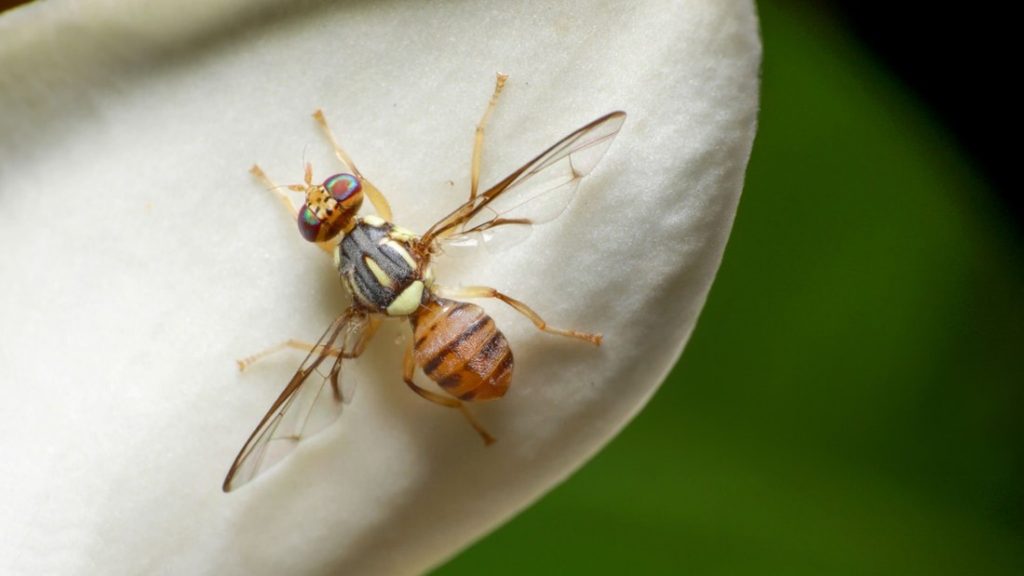

Thanks to the cooperation and diligence of California residents and local agricultural officials, the California Department of Food and Agriculture (CDFA), working in coordination with the United States Department of Agriculture (USDA), the Riverside County Agricultural Commissioner, and the San Bernardino County Agricultural Commissioner, has declared an end to the Oriental fruit fly quarantine in the Redlands area following eradication of the invasive species.
The lifting of this quarantine signals the successful completion of a nearly year-long collaborative effort to eradicate four unique invasive fruit fly species (Tau, Queensland, Mediterranean and Oriental) from seven quarantine areas across seven California counties — San Bernardino, Riverside, Los Angeles, Ventura, Santa Clara, Sacramento and Contra Costa.
“This was an unprecedented situation for California to experience this many active invasive fruit fly quarantines at one time,” said Victoria Hornbaker, director of CDFA’s Plant Health and Pest Prevention Services Division. “The response to these destructive invasive species was an enormous effort, and thanks to the cooperation of residents, the agricultural industry, and our government partners at the local and federal levels, we’re incredibly proud to have successfully lifted all active invasive fruit fly quarantines in the state of California.”
The USDA made critical investments in the response with personnel and funding, and that commitment underscores the importance of ongoing investment in pest exclusion activities.
It’s important to remember that the threat of new fruit fly introductions remains. Left unchecked, they can endanger the state’s natural environment, agriculture, and economy. Agricultural officials urge residents to follow simple precautions and stay vigilant for signs of invasive species. To help prevent any future introductions, residents should:
- Cooperate with agricultural officials and allow them access to your garden to place traps, inspect plants, conduct necessary treatments or remove potentially infested produce.
- Buy fruit trees and vegetable plants from licensed California nurseries. Purchasing agricultural goods from uncertified sources can spread invasive pests. Source your plants locally and responsibly. To find a licensed nursery near you, visit CDFA’s Directory of Licensed Nurseries.
- Inspect your garden for signs of invasive fruit flies or maggots and report any findings to CDFA at 1-800-491-1899 or your local county agricultural commissioner’s office.
- When entering the United States from another country, avoid bringing agricultural products — including fruits or vegetables. Help us protect our agricultural and natural resources and California’s unique biodiversity from invasive fruit flies — please Don’t Pack a Pest (www.dontpackapest.com) when traveling or mailing/receiving packages.
To learn more about invasive species and how to protect the county’s fruits and vegetables, visit CAFruitFly.com, rivcoawm.org or awm.sbcounty.gov.
Additional County Update News – August 15, 2024
- County health officer announces retirement
- Museum unveils STEAM Lab with ribbon-cutting ceremony and open house
- Registrar working with city clerks to cope with error
- County right-sizes use of videoconferencing sites
- Transient Occupancy Tax website unveiled
- Oriental fruit fly quarantine lifted in Redlands area
- County hosts successful street vending workshops
- Building Stronger Communities Together: National Night Out 2024
- Code Enforcement prevents potential disaster at unpermitted site
- Public Health hosts event celebrating National Breastfeeding Month
- Probation champions community safety and youth empowerment
- Plan for southbound 71 weekend full closure this weekend
- Museums offer new online system to schedule field trips
- Calling all artists for the 2024 Hispanic Heritage Month art exhibit
- Wellness Works Here: Start Your Journey
- Register for this year’s State of the County
- Clear the Shelters continues with low-cost adoptions Aug 10 – Sept. 10
- San Bernardino County destinations
- San Bernardino County history
- Things to Do
- Pet of the Week